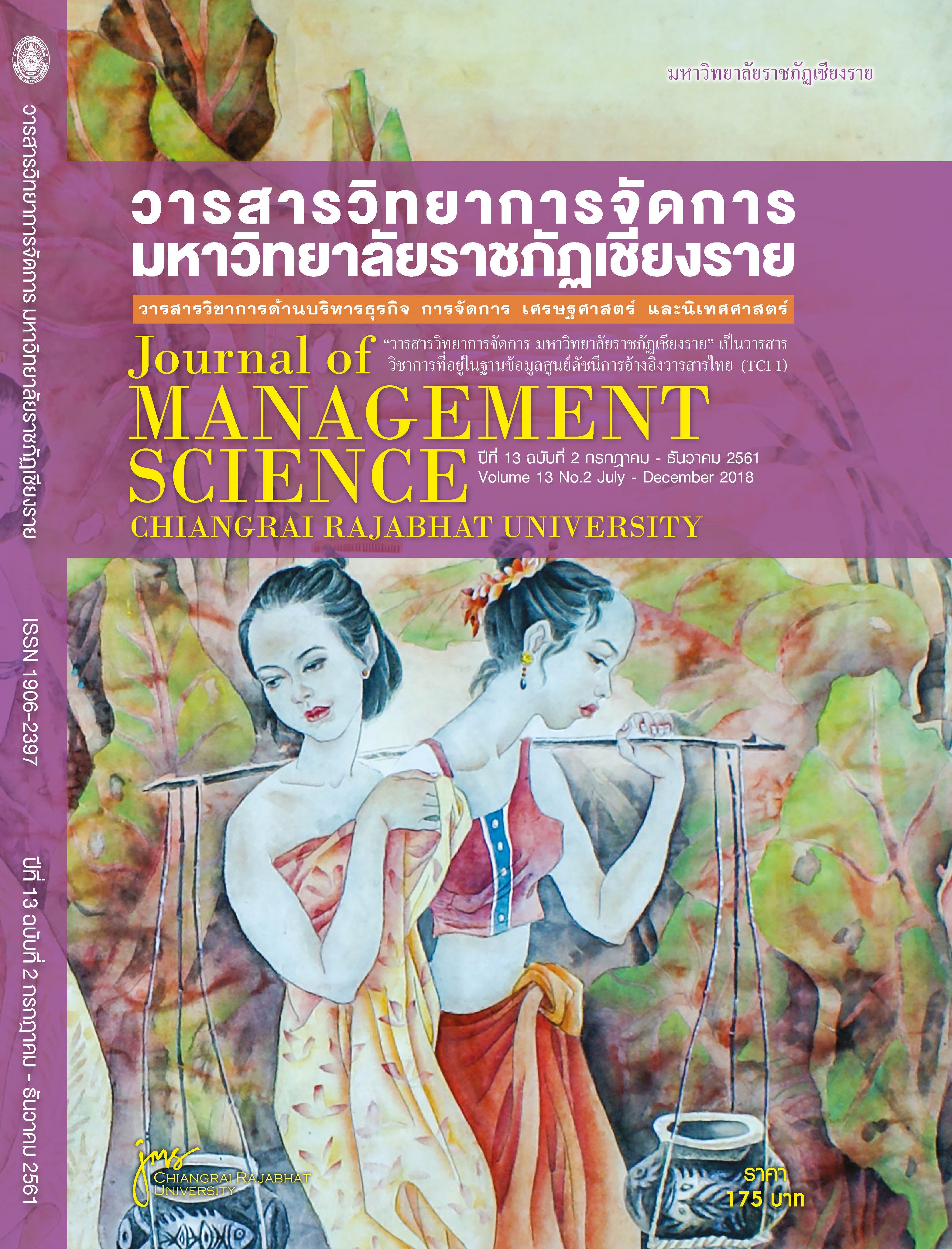Hospitality and Tourism Impact in Koh Yao Yai, Pang-Nga, Thailand Toward Perspective of Tourists and Locals
Main Article Content
Abstract
This qualitative research aims to study hospitality of local people for tourists, tourism impacts from the perspective of visitors and locals as well as to suggest the island to develop to be the sustainable site. This case study research collected data from 60 key informants including tourists 20 and locals 40 subjects during July 2016 by observation, structured in-depth interview and focus group discussion. The data analyzing process involved preparing, segmenting, coding, categorizing and thematizing. The results presented that the hospitality of local people also proved to all visitors as a good experienced tourism product in this island. The positive impact on economic side by income was increasing from tourism activities, people have more work, local products can be a sale, and hotel room price is low. The positive impact on socio-culture, locals were happy to welcome visitors and to serve them by the restaurant and rental transport services. The negative impacts, duet to the growth of tourism in this island, there are constructions of accommodation, and many labours come to work in the island that may issue the impacts to nature and community. The suggestion - leaders and villagers should engage more tourists to participate natural and cultural conservation.
Article Details
Views and opinions expressed in the journal do not necessarily reflect those of the editors.
References
Ap J, Crompton JL (1998). Developing and testing a tourism impact scale. J. Trav. Res. 37(2): 120-130 Arnstein, S. R. (1969). A ladder of citizen participation. Journal of the American Institute of Planners. 35(4), 216 – 224.
Baum, T. (2012). Human resource management in tourism: a small island perspective. International Journal of Culture, Tourism and Hospitality Research. 6(2), 124-232.
Brotherton. B. (1999). Towards a definitive view of the nature of hospitality and hospitality management. International Journal of Contemporary Hospitality Management. 11(4), 165-173.
Cater, E. (1994). Ecotourism in the Third World: Problems and Prospects for Sustainability. Chichester: John Wiley & Sons, 69 – 86.
Cave, J. & Brown, K.G. (2012). Island tourism: destinations: an editorial introduction to the special issue. International Journal of Culture, Tourism and Hospitality Research. 6(2), 95-113.
Chen SL, Guo BC (1995). Perceptions of residents at Guanyinshan Scenic area of the impact of tourism development. J. Tour. Stud. 1(2): 48-58
Choibamroong, T. (2014). Tourism Development & ASEAN Tourism Development. University of Phayao.
David, L. (2011). Tourism ecology: towards the responsible, sustainable tourism future. Worldwide Hospitality and Tourism Themes. 3(3), 210-216.
Green, H. (1995). Planning for sustainable tourism development. Tourism and the environment: a sustainable relationship?. London: Routledge.
Hanks, P. (Ed.) (1989). The Collins Concise Dictionary Plus, Collins, Glasgow.
Jamal, T.B. & Getz, D. (1995). Collaboration theory and community tourism planning. Annals of Tourism Research. 22(1), 186 – 204.
Ko D, Stewart WP (2002). A structural equation model of residents’ attitudes for tourism development. Tour. Manage. 23(2): 521-530.
Leslie, D. (1993). Developing sustainable tourist. Tourism Management. 14, 485.
Liu, C. & Yen, L. (2010). The effects of service quality, tourism impact, and tourist satisfaction on tourist choice of leisure farming types. African Journal of Business Management. 4(8), 1529-1545.
McNeil, R. (2016). Phang Nga's Koh Yao Noi Homestay wins best homestay award in ASEAN Homestay Awards 2016-18. Retrieved August 1, 2016, from https://thainews.prd.go.th/website_en/news/news_detail/WNECO5903210010017
Murphy, P.E. (1985). Tourism: A community approach. New York and London: Methuen.
Murphy, P. E. (1988). Community driven tourism planning. Tourism Management, 9, 96-104.
Naipinit, A. & Maneenetr, T. (2010). Community Participation in Tourism Management in Busai Village Homestay, Wangnamkheo District, Nakhon Ratchasima Province, Thailand. International Business & Economics Research Journal. 9(1), 103 – 110.
Oxford University Press. (2008). Oxford Learner’s Thesaurus CD-ROM, Oxford, UK
Padin. C. (2012). A sustainable tourism planning model: components and relationships. European Business Review. 24(6), 510-518.
Richard. P. et al. (2015). CBT ASEAN Marketing. Community Based Tourism Institute and Payup University, CBT ASEAN Marketing seminar on 30 May 2015 at Tharin Hotel Chiang Mai.
Rodrigues de Jesus, V.L. (2010). Developing sustainable tourism in the Amazon rainforest of Brazil – premises, actions, challenges. Worldwide Hospitality and Tourism Themes. 2(2), 144-152.
Sanchez-Canizares S. M. & Castillo-Canalejo. A. M. (2014). Community-based island tourism: the case of Bao Vista in Cape Verde. International Journal of Culture, Tourism and Hospitality Research. 8(2), 219 – 233.
Sharma, B. & Dyer, P. (2009). Residents’ involvement in tourism and their perceptions of tourism impacts.
Benchmarking: An International Journal. 16(3), 351-371.
Tatoglu, E., Erdal, F., Ozgur, H. & Azakli, S. (n.d.). Resident Perceptions of the Impact of Tourism in a Turkish Resort Town. Retrieved February 2, 2018, from https://info.opf.slu.cz/vvr/akce/turecko/pdf/Tatoglu.pdf
Taweekul, P. (2001). The participation of People in Sustainable Tourism Attraction Management: Case Study of Ban Laihin, Koh Ka District, Lampang. Chiang Mai : Chiang Mai University. The World’s 14 Most Beautiful Unspoiled Island. (2015). Retrieved September 28, 2015, from https://www.yahoo.com/travel/the-worlds-14-most-beautiful-unspoiled-islands-128349328147.html
Wongpan, S. & Khamwon, A. (2017). Destination Brand Experience, Satisfaction and Behavioral Intention: Evidence from MICE Khon Kaen. Journal of Mangement Science, Chiang Rai Rajabhat University, 12(2), 1-16.
Yen, H. H. (1994). A study on the perception of tourism impacts in Kin-Men. Master thesis. Dept. of Horticulture, National Chung-Hsing University, Taichung


